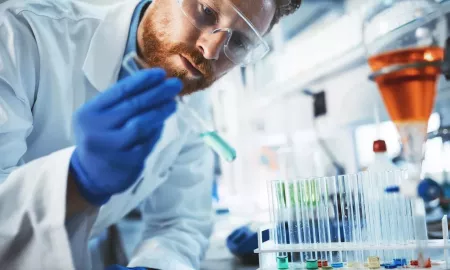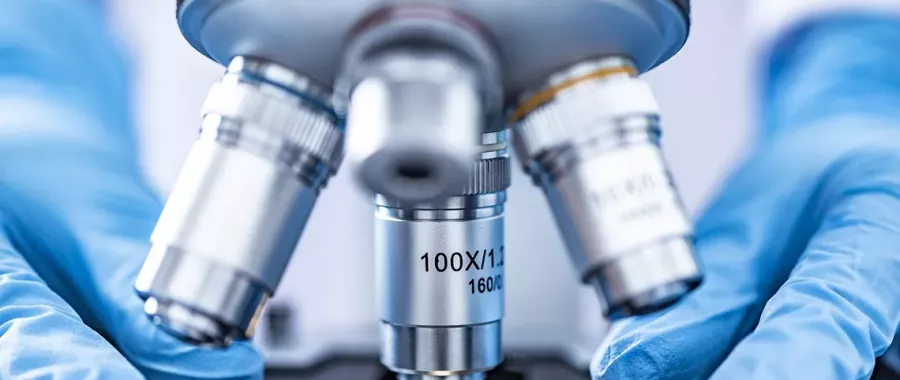Unknown materials and substances found on-site, in products, or during processing can be a major cause for concern. Being able to effectively and precisely identify them enables public and private sector organisations such as corporations, police, hospitals and councils to take action to prevent risk.

Unknown materials and substances found on-site, in products, or during processing can be a major cause for concern. Being able to effectively and precisely identify them enables public and private sector organisations such as corporations, police, hospitals and councils to take action to prevent risk.
Paul Walker, senior development specialist at SOCOTEC, takes us through the processes of a chemical investigation, to show how we move from the unknown to the known. Unexpected and unidentified substances such as solids, solvents, deposits, oils and dusts can show up in any environment, from large industrial factories to building sites, crime scenes to hospital wards, pharmaceutical clean rooms to everyday households. Probably the most frequently received at the laboratory are unknown dusts, as they can clearly pose an immediate risk to staff health and safety.
Other types of deposit often only come to light when they begin to cause an issue and can include: sticky residues causing issues with machinery, solids blocking fuel injector nozzles, unknown particles in vaccines and foods, foreign objects on contact lenses, contamination in packaging, premature blocking of fuel and air filters, and staining on buildings. All these events can have an impact on the SHEQ goals of an organisation or body.
Examples of events impacting SHEQ:
Safety greasy deposit on brake pads of vehicle, compromising braking efficiency
Health unknown dust contaminating a work area or house
Environment suspect fly-tipped material poisoning the environment
Quality unknown particle in a vaccine
Chemical investigation can be quite a varied job, with a wide diversity of contaminated articles being sent for investigation, such as pieces of plastic/rubber from the breakdown of the conveyor belts found in food airborne fibres found floating in medical vaccines deposits on medical instruments such as bone fragments and rusting deposits affecting delivery of materials via medical needles, catheters etc barrels of unknown solids and liquids from fly-tipping or landfill.
With this variety of source material, scientists need process to bring clarity. Chemical investigations utilise rapid identification methods which give peace of mind that contaminants will be classified swiftly, reducing process disruption and providing key information for failure investigations, manufacturing issues and health and safety concerns. A mis-identification must be avoided at all costs as it could send a failure investigation down the wrong route and reach the wrong conclusion, and ultimately the wrong solution.
Sample Integrity
Wherever possible, the article that has been contaminated should be sent in for investigation intact. This will allow the laboratory to take direct samples, and also see how the material lies on the sample. For substances found on surfaces, this could be an important step in determining what the unknown material is and how it has been deposited; for example, if the deposit is in a watermark pattern then it shows the deposit has been formed from the evaporation of liquids on the surface. If the original article itself cannot be sent in, then often a sample is placed into a glass container, between glass microscope slides or, failing that, then swabs can be taken. Swabs, however, can limit the type of analysis that can be done as background contamination from the swabs themselves may occur.
 Potential contamination, of the investigator or of the article itself, is a real issue and needs to be overcome when working with minute contamination. Work should be carried out in a clean room, preferably with a positive pressure environment to stop dust and fibres from contaminating the surrounding area. In addition to controlling contamination from the laboratory, other basic principles that need to be followed during a chemical investigation include good note keeping and photographic documentation of any physical characteristics identified through the process.
Potential contamination, of the investigator or of the article itself, is a real issue and needs to be overcome when working with minute contamination. Work should be carried out in a clean room, preferably with a positive pressure environment to stop dust and fibres from contaminating the surrounding area. In addition to controlling contamination from the laboratory, other basic principles that need to be followed during a chemical investigation include good note keeping and photographic documentation of any physical characteristics identified through the process.
A bespoke approach
Every investigation has to be bespoke to the sample. Before any investigation is started, the most important thing is to find out as much about the sample as possible - such as: where it was found, what work is carried out around the site, how much of the sample is present, is it a recent development or has it been developing over time? Detailed discussions with the client take place to understand the processes that are employed in the area and so potential sources can be identified and taken into account when designing the analytical experiments.
When the sample arrives in the laboratory, the first thing that always happens is a physical examination. This examination will give the first impression of the sample and what analysis should potentially be started with, as well as what analysis is available due to sample size. Extremely small samples might limit the type of analysis that can be performed due to sensitivity of the laboratory instrumentation.
Common analysis carried out include Fourier Transform Infrared Spectroscopy (FTIR), Gas Chromatography Mass Spectrometry (GC/MS), Scanning Electron Microscope using Energy Dispersive X-ray analysis (SEM-EDX), Inductively Coupled Plasma Mass Spectrometry (ICP-MS) and Ion Chromatography (IC). The types of laboratory analysis performed on each sample is determined by the expert scientists working on the case.
Identifying the Unknown
Once all this information is collated, we can start to make hypotheses about what might have happened and how the unknown substance could have come to occur. It is important that assumptions do not start to take root, as these can influence the interpretations rather than simply drawing on the analytical results.
Each stage of the investigation tells us a bit more about the sample such as GC/MS gives the volatile/semi-volatiles organics, the SEM-EDX giving the elemental composition, the IC analysis giving the anions and so on. It is very rare that just one analytical technique will allow you to confidently state what the sample is. Instead, each stage builds on the one before to form a picture of what the sample is. We are also looking to see if the different techniques confirm what each one is telling us or question what the initial results were, and it usually takes several days to form a complete picture.
* This article first appeared in Labmate Online.
Read about Theory in Practice
Our chemical analysis laboratory received an engine turbo air filter which had become mysteriously blocked by an unknown deposit. The premature blocking of the filter had led to damage of the engine turbo on class 172 vehicles due to reduced air flow through the turbo, which in turn, resulted in a loss of power to the engine.
Find out more about how our Specialist Chemistry team uncovered the mystery, click here.
Want to find out more about SOCOTEC's chemical investigation services?

You might also like







Add new comment